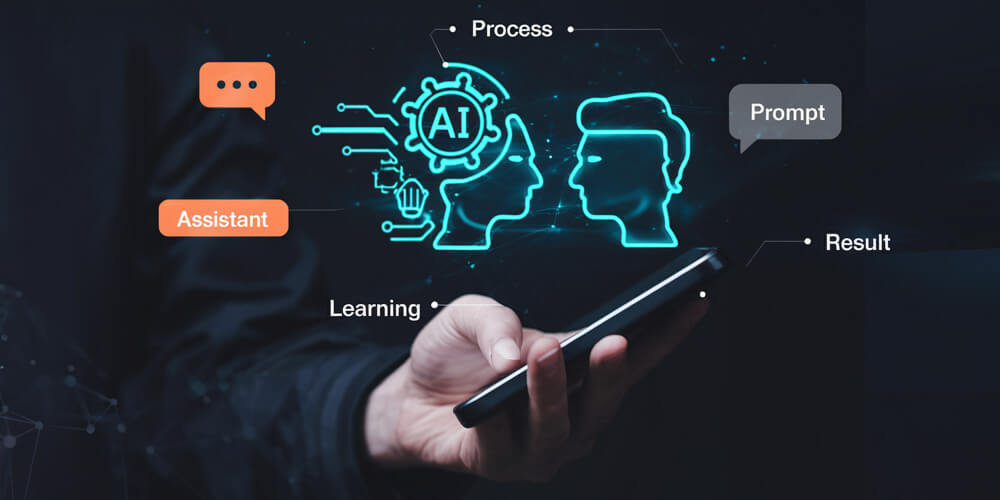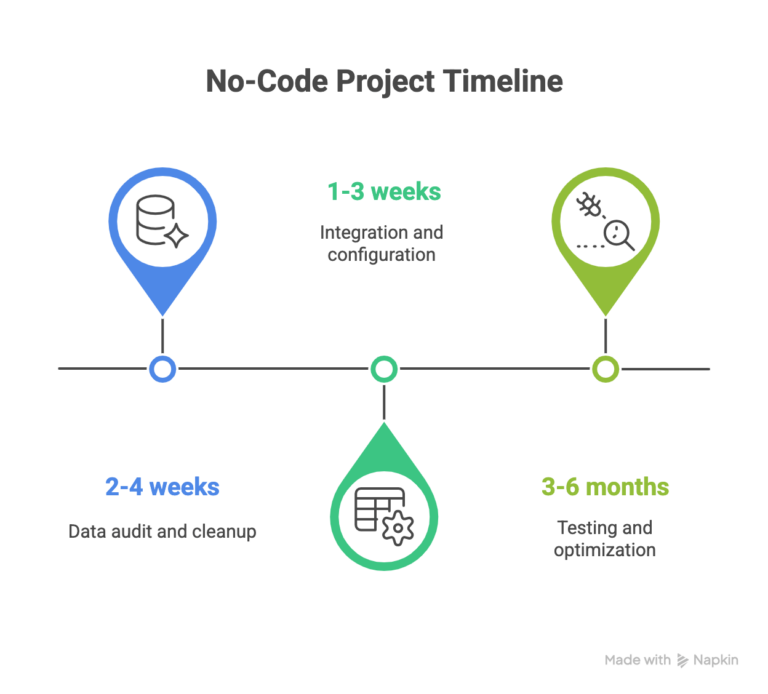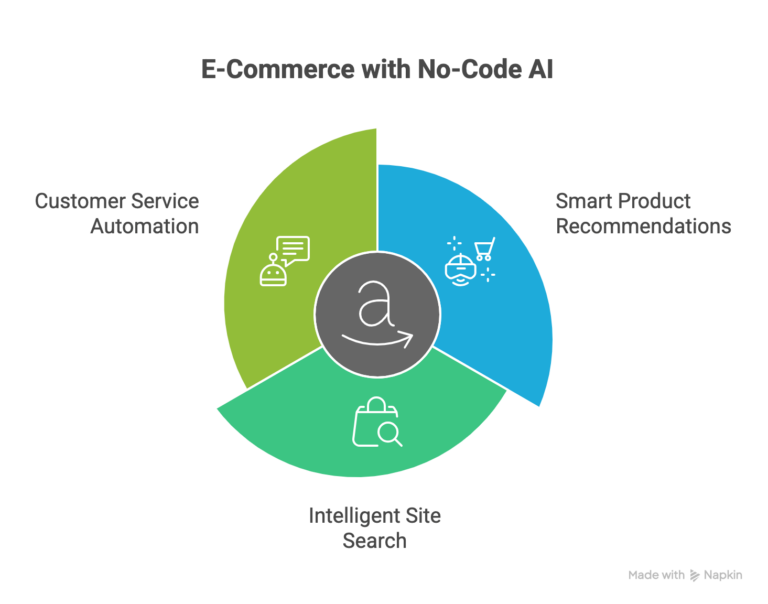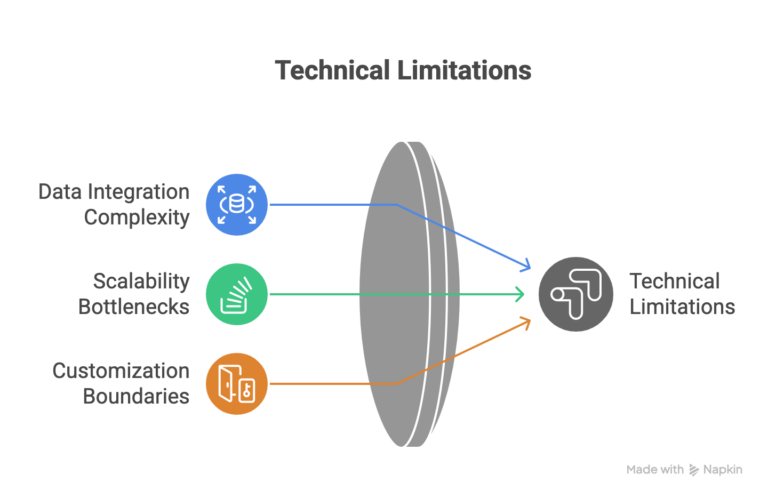Greetings! I'm Aneesh Sreedharan, CEO of 2Hats Logic Solutions. At 2Hats Logic Solutions, we are dedicated to providing technical expertise and resolving your concerns in the world of technology. Our blog page serves as a resource where we share insights and experiences, offering valuable perspectives on your queries.

Quick Summary
No-code AI platforms let e-commerce businesses implement AI features like recommendations and search without coding, but success requires significant strategy work and data preparation beyond platform setup.
They work well for standard use cases under $10M revenue but have limitations with data integration, scalability, and customization. Businesses should graduate to custom development when AI becomes central to their competitive strategy or when platform constraints limit growth.
The question isn’t whether to implement AI in your e-commerce business; it’s whether to build competitive differentiation or operational efficiency. This fundamental choice determines whether no-code platforms or custom development serve your strategic objectives.
Through our work with e-commerce brands across different growth stages, we’ve developed a clear methodology for aligning the AI implementation approach with business strategy. The results speak for themselves.
What Is No-Code AI?
No-code AI platforms let you build artificial intelligence solutions without writing code.
But here’s the reality check: “no-code” doesn’t mean “no-effort.”
Traditional AI development requires data scientists, coding, and infrastructure investment. No-code AI offers pre-trained models and intuitive interfaces that aim to simplify this complexity.
The catch? Success still depends heavily on your data quality, strategic thinking, and ongoing optimization efforts. The platforms handle the technical complexity, but you’re responsible for the strategic implementation.
Reality of No-Code AI Implementation
Let’s address the elephant in the room. After working with dozens of e-commerce businesses, we observed what we call the 70/30 rule: 70% of your effort goes to strategy and optimization, while only 30% involves platform setup.
What “no-code” actually requires:

- Data audit and cleanup: 2-4 weeks of organizing product information and customer data
- Integration and configuration: 1-3 weeks connecting systems and setting up workflows
- Testing and optimization: 3-6 months of continuous refinement and improvement
Most businesses expect the opposite ratio. They think AI platforms will handle strategy while they focus on setup. The reality is backwards.
Pro Tip: Before evaluating any platform, audit your data quality and define strategic objectives. The platform is just the tool; success depends on your foundation.
E-Commerce Use Cases Where No-Code AI Works
After implementing dozens of AI solutions, we’ve identified specific e-commerce use cases where no-code platforms consistently deliver results and others where they consistently disappoint.

Smart Product Recommendations
Product recommendations are the sweet spot of no-code AI. Platforms such as Yotpo and Dynamic Yield offer sophisticated algorithms that require no human data science expertise.
Being based on real performance data, around 35% of Amazon’s revenues are based on recommendations, while e-commerce businesses typically see a 10-30% average order value increase.
To achieve such results, however, requires months of optimization. Initial recommendations tend to be generic and underperforming.
Intelligent Site Search
The AI search tackles a big problem: 41% of top e-commerce sites have bad search functions. A no-code platform such as Klevu implements natural language processing that understands the user’s intent, even if the query is spelled incorrectly.
Some major capabilities include semantic search, understanding “comfortable running shoes” vs. “professional dress shoes” keyword searches, auto-complete suggestions, and visual search for image-based discovery.
Customer Service Automation
AI chatbots, correctly implemented, handle about 80% of routine inquiries. Companies like Intercom offer the gift of conversational AI without the need to master natural language processing.
Success entails methods where complicated issues are passed onto a human, responses are context-aware, and the system continually learns from interactions with customers, considering prior interactions with the customer.
Struggling with the no-code vs. custom decision?
Technical Limitations
Understanding no-code AI limitations isn’t about finding flaws; it’s about making informed decisions that prevent costly mid-implementation pivots to custom development.

Data Integration Complexity
Your e-commerce data lives everywhere: CRM systems, ERPs, marketing tools, analytics platforms. Most businesses have 5-15 different data sources needing coordination.
No-code AI platforms excel with clean, centralized data but struggle with real-world complexity, including data silos, inconsistent formats, and real-time synchronization requirements.
Scalability Bottlenecks
No-code platforms are designed for standardized use cases. Common constraints include:
- Transaction volume limits that become expensive at scale
- Customization boundaries where business logic exceeds platform flexibility
- Performance optimization requires custom infrastructure
When Customization Hits Boundaries
Every business has unique requirements. No-code platforms excel at common scenarios but struggle with business-specific needs like algorithm modification, custom data processing, and proprietary system integration.
Success Stories
A $5M fashion retailer implemented Yotpo recommendations and Klevu search:
Month 1: Setup took 3 weeks, not 1 week promised. Data integration revealed inconsistent categorization.
Months 2-3: 40+ hours cleaning product data. Had to implement additional customer tracking.
Months 4-6: Achieved 22% average order value increase and 18% cart abandonment reduction.
What success really required:
- Weekly A/B testing of algorithms
- Monthly customer behavior analysis
- Quarterly strategy reviews
- 15 hours weekly from the marketing manager
- Monthly technical consultant support
The “set it and forget it” promise is marketing fiction. Success requires treating AI as an ongoing optimization process.
When to Switch from No-Code AI to Custom Development
Across our client implementations, specific warning signs consistently indicate when businesses have outgrown no-code platforms and need custom development for continued growth.
Warning signs you’ve outgrown no-code:
- Platform response times slow during peak traffic
- Monthly costs approach custom development prices
- Need features unavailable in the platform
- Complex business rules don’t fit templates
Enterprise complexity indicators:
- Multiple brands or international markets
- Advanced personalization beyond demographics
- Real-time optimization requirements
- Proprietary algorithms for competitive advantage
Strategic decision framework:
- Stick with no-code: Standard use cases, budget constraints, timeline pressure
- Invest in custom: AI central to competition, complex requirements, scale needs
- Consider hybrid: Use no-code for basics, custom for differentiators
Data Architecture: The Make-or-Break Factor
Why 60% of projects fail: Data problems, not platform limitations.
Common data issues:
- Incomplete customer behavioral data
- Inconsistent product categorization
- Fragmented transaction information
- Real-time synchronization failures
Essential requirements:
- Customer profiles: 6+ months of behavioral data
- Product info: comprehensive attributes for 80% of inventory
- Accuracy: below 5% error rates
- Timeliness: real-time or 15-minute updates
Pro Tip: Invest in data architecture before selecting platforms. Clean, integrated data delivers 3x better results regardless of platform choice.
The Strategic Decision Framework
Most businesses evaluate AI solutions based on features and pricing, missing the strategic factors that determine whether their choice supports or limits future growth.
Self-assessment questions:
- Do you have clean, consistent customer data?
- Can you dedicate 10-20 hours monthly to optimization?
- Do your requirements fit standard use cases?
- Can you budget 6-12 months for gradual improvement?
DIY makes sense when:
- Revenue under $10M with growth trajectory
- Standard e-commerce model
- Team capacity for learning platforms
- AI as a supporting feature, not a core differentiator
Professional implementation when:
- AI central to competitive strategy
- Complex business logic needs
- Performance demands exceed platforms
- Budget available for custom development
Custom AI Development
While no-code platforms democratize AI access, custom development creates proprietary advantages that shared platforms cannot deliver.
When custom AI makes strategic sense:
Competitive differentiation: Proprietary algorithms become your moat. A luxury fashion retailer’s custom AI factors style compatibility, seasonal trends, and inventory turnover simultaneously – converting 40% higher than platform alternatives.
Complex business logic: Enterprise operations need AI reflecting sophisticated business rules. Multi-brand catalogs, international pricing, and supply chain optimization often exceed platform templates.
Scalability without constraints: High-volume operations require performance beyond platform capabilities. Custom solutions handle millions of interactions at consistent speeds while platforms slow during peak traffic or require costly upgrades.
Strategic advantages include data ownership and algorithm control, unlimited integration flexibility with existing tech stacks, and future-proof investment that evolves with business needs rather than vendor roadmaps.
Investment criteria: Custom development makes sense when AI is central to competitive strategy, annual revenue exceeds $10M with growth requirements, complex business needs don’t fit templates, and performance demands exceed platform capabilities.
Resource reality: 3-6 months development timeline, less ongoing optimization than platforms since solutions are purpose-built, but requires specialized expertise through internal teams or agency partnerships.
Strategic insight: The most successful businesses often start with no-code platforms to understand requirements, then invest in custom development for core differentiating features while maintaining platforms for standard functionality.
Ready to evaluate if custom AI makes sense for your business?
Looking Forward
No-code AI is becoming more sophisticated but also more complex. Advanced personalization and multi-modal AI are emerging, but customization limits remain.
Enterprise trends toward custom implementation reflect growing recognition that competitive advantage requires proprietary solutions, not shared platforms.
The hybrid future: Most successful businesses start with no-code to understand requirements, then graduate to custom solutions for competitive advantages while maintaining platforms for standard functionality.
Making the Right Choice for Your Business
No-code AI has democratized artificial intelligence, making powerful tools accessible without technical teams. It works brilliantly for standard applications but has limitations for complex, scalable implementations.
Success depends more on strategy and data quality than platform choice. Whether you start with no-code or jump to custom implementation depends on your specific needs, resources, and growth trajectory.
FAQ
What's the main difference between no-code AI and custom AI development?
No-code AI uses pre-built platforms with drag-and-drop interfaces that require no programming skills, while custom AI development involves building tailored solutions from scratch using code. No-code is faster to implement but has limitations in customization and scalability, while custom development takes longer but offers unlimited flexibility and competitive differentiation.
Is no-code AI really "no effort" to implement?
No. Success follows the 70/30 rule: 70% of effort goes to strategy, data preparation, and ongoing optimization, while only 30% involves platform setup. You'll need 2-4 weeks for data cleanup, 1-3 weeks for integration, and 3-6 months of continuous optimization.
What are the biggest limitations of no-code AI platforms?
Key limitations include data integration complexity across multiple systems, scalability bottlenecks at enterprise level, customization boundaries when business logic exceeds platform templates, and performance optimization constraints during peak traffic periods.
When does custom AI development make sense for e-commerce?
Custom development is ideal when AI is central to your competitive strategy, you have complex business logic needs, performance demands exceed platform capabilities, you need proprietary algorithms for differentiation, or you're managing multiple brands/international markets with unique requirements.
Table of contents
- What Is No-Code AI?
- Reality of No-Code AI Implementation
- E-Commerce Use Cases Where No-Code AI Works
- Technical Limitations
- Success Stories
- When to Switch from No-Code AI to Custom Development
- Data Architecture: The Make-or-Break Factor
- The Strategic Decision Framework
- Custom AI Development
- Looking Forward
- Making the Right Choice for Your Business

Related Articles







